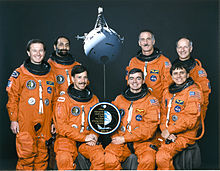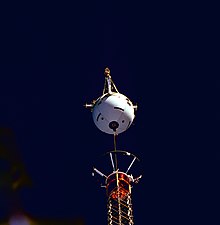STS-75
This article includes a list of references, related reading, or external links, but its sources remain unclear because it lacks inline citations. (May 2008) |
| COSPAR ID | 1996-012A |
|---|---|
| SATCAT no. | 23801 |
| End of mission | |

 | |
STS-75 was a United States Space Shuttle mission, the 19th mission of the Columbia orbiter.
Crew
| Position | Astronaut | |
|---|---|---|
| Commander | Andrew M. Allen Third spaceflight | |
| Pilot | Scott J. Horowitz First spaceflight | |
| Mission Specialist 1 | Jeffrey A. Hoffman Fifth spaceflight | |
| Mission Specialist 2 | Maurizio Cheli, ESA First spaceflight | |
| Mission Specialist 3 | Claude Nicollier, ESA Third spaceflight | |
| Mission Specialist 4 | Franklin R. Chang-Diaz Fifth spaceflight Payload Commander | |
| Payload Specialist | Umberto Guidoni, ASI First spaceflight | |
Mission parameters
- Mass: 10,592 kg payload
- Perigee: 277 km
- Apogee: 320 km
- Inclination: 28.5°
- Period: 90.5 min
Mission objective
The primary objective of STS-75 was to carry the Tethered Satellite System Reflight (TSS-1R) into orbit and to deploy it spaceward on a conducting tether. The mission also flew the United States Microgravity Payload (USMP-3) designed to investigate materials science and condensed matter physics.

The TSS-1R mission was a reflight of TSS-1 which was flown onboard Space Shuttle Atlantis on STS-46 in July/August 1992. The Tether Satellite System circled the Earth at an altitude of 296 kilometers, placing the tether system within the rarefied electrically charged layer of the atmosphere known as the ionosphere.
STS-75 mission scientist hoped to deploy the tether to a distance of 20.7 km (12.9 mi). Over 19 kilometers of the tether were deployed before the tether broke. It remained in orbit for a number of weeks and was easily visible from the ground, appearing something like a small but surprisingly bright fluorescent light traveling through the sky.
The specific TSS1-R mission objectives were: characterize the current-voltage response of the TSS-orbiter system, characterize the satellite's high-voltage sheath structure and current collection process, demonstrate electric power generation, verify tether control laws and basic tether dynamics, demonstrate the effect of neutral gas on the plasma sheath and current collection, characterize the TSS radio frequency and plasma wave emissions and characterize the TSS dynamic-electrodynamic coupling.
TSS-1R Science Investigations included: TSS Deployer Core Equipment and Satellite Core Equipment (DCORE/SCORE), Research on Orbital Plasma Electrodynamics (ROPE), Research on Electrodynamic Tether Effects (RETE), Magnetic Field Experiment for TSS Missions (TEMAG), Shuttle Electrodynamic Tether System (SETS), Shuttle Potential and Return Electron Experiment (SPREE), Tether Optical Phenomena Experiment (TOP), Investigation of Electromagnetic Emissions by the Electrodynamic Tether (EMET), Observations at the Earth's Surface of Electromagnetic Emissions by TSS (OESSE), Investigation and Measurement of Dynamic Noise in the TSS (IMDN), Theoretical and Experimental Investigation of TSS Dynamics (TEID) and the Theory and Modeling in Support of Tethered Satellite Applications (TMST).
The USMP-3 payload consisted of four major experiments mounted on two Mission Peculiar Experiment Support Structures (MPESS) and three Shuttle Mid-deck experiments. The experiments were: Advanced Automated Directional Solidification Furnace (AADSF), Material pour l'Etude des Phenomenes Interessant la Solidification sur Terre et en Orbite (MEPHISTO), Space Acceleration Measurement System (SAMS), Orbital Acceleration Research Experiment (OARE), Critical Fluid Light Scattering Experiment (ZENO) and Isothermal Dendritic Growth Experiment (IDGE).
STS-75 also was the first use of Linux operating system on orbit. An older Digital Unix program, originally on DEC Alpha servers, was ported to run on Linux on a laptop. The next use of Linux was a year later, on STS-83.[1]
STS-75 was the shuttle mission described in the fictional NASA Document 12-571-3570, although this document was disseminated several years before STS-75 was launched. The document purports to report on experiments to determine effective sexual positions in microgravity. Astronomer and scientific writer Pierre Kohler mistook this document for fact and is responsible for a major increase in its redistribution in the early 21st century.

